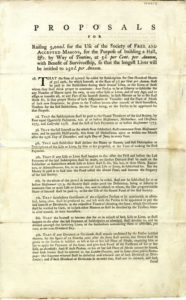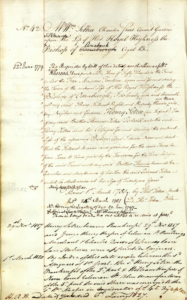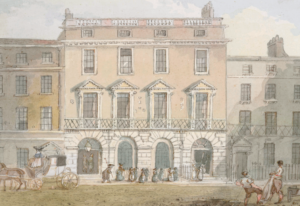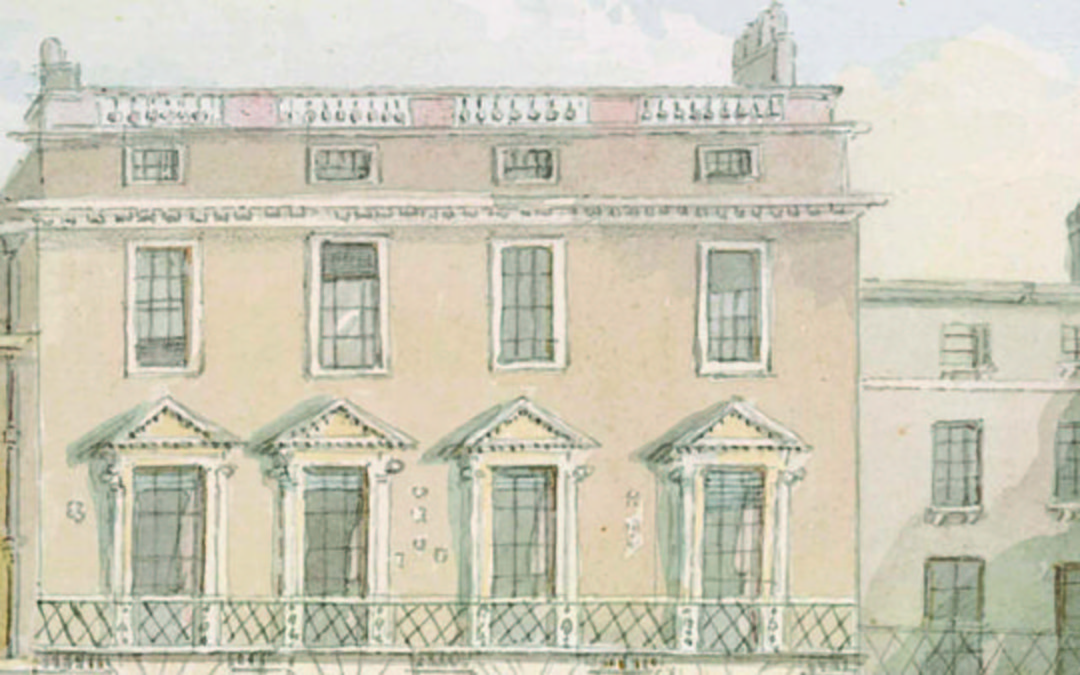By Diane Clements
In 2018 Diane Clements graduated with an MRes from the Institute of Historical Research. Her 30,000-word dissertation looked at the workings of an eighteenth-century ‘tontine’, offering new insight on attitudes to private investment and identity in late Hanoverian Britain.
The notion of a ‘gambling mania’ in eighteenth-century Britain is one that’s been widely subscribed to by historians. The century saw not only the origins of classic English horse races, but also an emerging insurance market which facilitated betting on lives and the use of lotteries, sweepstakes and tontines to encourage investment in public debt and to finance local infrastructure. This idea of a peculiarly Hanoverian ‘mania’ is also encapsulated in numerous caricatures of politicians and public figures compulsively playing for high stakes in games of chance and hazard. However, my recent study of one example of these popular eighteenth-century financial vehicles – the Freemasons’ tontine of 1775 – suggests a more complex correlation between gambling and investment, and a more sophisticated contemporary view of risk and reward.
What was a tontine?
In 1775 the Grand Lodge of English freemasons acquired a site in Great Queen Street, Lincoln’s Inn Fields, London, where it was intended to build the society’s first headquarters. They chose to raise the cost of £5,000 by selling one hundred shares of £50 each in the Freemasons’ tontine.

A tontine was a form of life annuity with, in the terminology of the eighteenth century, ‘the benefit of survivorship’. There were four roles within it. The issuer was the borrower and initiator of the tontine (in this case the Freemasons). The subscriber provided the initial capital subscription and when doing so had to nominate a life, known as the ‘nominee’. The shareholder or proprietor was the person entitled to receive the annual interest on the tontine share, a payment often referred to as the dividend. The nominee was the person on whose life the contract was contingent. A dividend was paid to a shareholder for so long as his or her nominee was alive.
The total annual dividend paid by the issuer remained unchanged but as nominees died, this total was divided between fewer people; shareholders with living nominees duly received an increased dividend year on year. Eventually the shareholder whose nominee was the one remaining survivor received the whole dividend. The issuer did not have to repay the capital sum but had a commitment to pay the dividend for as long as there were any surviving nominees.
In some cases, where the subscriber paid for the share, nominated his or her own life, and continued to receive the dividend until death, the three roles of subscriber, shareholder and nominee were vested in the same person. The roles could also be held by different people. A subscriber who nominated another person and paid for the share could remain as the shareholder; but he or she might also sell, transfer or gift the share to a third party who in turn became the shareholder, receiving the dividend until the death of the nominee chosen by the original subscriber. In the case of the Freemasons’ tontine, when £5,000 was raised at a nominal interest rate or dividend of 5% per annum, the total annual dividend was £250. The original annual dividend per share was £5. The final nominee died in 1862.
Development of the Freemasons’ tontine, 1775-1862
The Freemasons’ tontine is unusual in that records have survived for its duration. These supported my dynamic, longitudinal study from the multiple perspectives of its issuer, investors and beneficiaries. The records form part of the archives of the United Grand Lodge of England, the governing body for freemasonry in England and Wales, and are held at the Library and Museum of Freemasonry in London. They include the terms of the tontine, set out in a printed prospectus, and printed lists of subscribers.
A register of tontine shares was maintained by the issuer in which each of the 100 shares was numbered and allocated a page.

This record provides for each share the name of the original subscriber with an address and occupation, and details of their nominee including age, address and any familial relationship. The register recorded subsequent changes in ownership of the share through inheritance, sale or other transfer, plus details of the nominee, including any change of name on marriage and, of course, details of his or her death. These sources have made it possible to identify the individual investors and to infer their investment motivations with emphasis on their original choice of nominee and any subsequent disposal decisions.
Why did people invest?
My research hasn’t uncovered any new types of investor but it has reinforced the existing model, shown in studies of the public debt market, of an investment community comprising the property-owning commercial and professional classes, largely male, but with a significant part played by widows and single women. There was a consistent pattern of investors subscribing for tontine shares as an investment to support both the individual investor and wider family. This investment strategy was also evident in subsequent decisions about the disposal of shares. It was typically expressed by nominating a young child of the family and then bequeathing the share to him or her, assuming they were still alive, on the death of the original subscriber. A tontine share was also a popular form of life annuity, where the investor nominated him or herself, providing that individual with a modest (but growing) lifetime income.
Who were the nominees?
Whatever the motivation of investors, the central focus of the tontine was the nominee whose life was key to the investor receiving his investment return. Tontines had to set their own criteria to document personal identity and ensure that annual payments were properly calculated and claims to them justified. It was in the interest of an individual investor to prove his own and his nominee’s identity as easily as possible. As this period pre-dated the introduction of civic registration (in 1837) investors had to decide for themselves what were the constituents of personal identity. The inconsistency of information they provided, as recorded in the tontine register, is evidence of the differing approaches to identity and its affirmation in the pre-modern era.
The Life Assurance Act of 1774 prohibited life insurance where the insurer had no insurable interest in the life or death of the person insured. As the Act did not apply to tontines, it was possible for six of the scheme’s 57 individual subscribers to nominate the life of a public figure with whom they had no legal or familial connection. The tontine offered these investors a speculative opportunity to gamble on an unrelated life which they might previously have satisfied in the insurance market. The most popular choice of public figure was George, Prince of Wales, aged fourteen in 1775.
If the choice of a public figure, like George, was a form of speculation, then it could also be considered prudential. Although premature death of royal or aristocratic children was not unknown, public figures were likely to have the benefit of a lifetime of high-quality care. Almost all the public figures nominated in the Freemasons’ tontine lived until the 1820s and ’30s and proved to be lucrative investments. Despite the speculative element of this choice, their public profile had a further advantage. Claiming the regular half-yearly dividend required each investor to prove, to the satisfaction of the issuer, the identity and continued survival of his nominee. Choosing a nominee whose life events, and especially his or her death, would be widely reported removed a significant administrative hurdle for both investor and issuer.

Tontines, risk and investment
A degree of risk-taking was inherent in a tontine on the part of both subscriber and issuer. Each had to make judgments about mortality and identity which would determine the extent of the former’s investment return and the latter’s total outlay set against the original sum borrowed. The use of tontines appears to support the view of several historians that risk-taking was endemic in eighteenth-century British society. However, my study of the Freemasons’ tontine shows that, despite poor contemporary understanding of mortality statistics, investment in a tontine was a rational choice. At a time of relatively unsophisticated financial markets, tontine investors achieved an enhanced return on their investment, and gained a regular income for themselves and other family members.

Diane Clements gained a distinction for her 2018 MRes thesis, ‘Invested in identity: the Freemasons’ tontine of 1775′. She is currently studying for a PhD on personal lending and the market in annuity loans in late eighteenth-century Britain.

